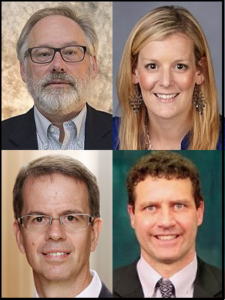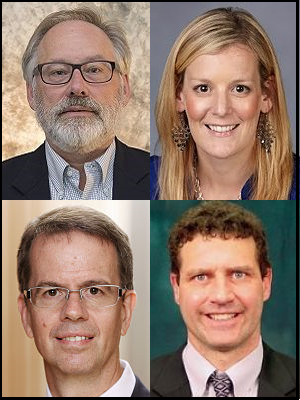Archived Webinar: Understanding America’s Rural-Urban Interface
America’s rural-urban divide, it seems, has never been greater, a point reinforced by large geographic disparities in support for Donald Trump in the 2016 presidential election. But it is also the case that big cities and rural communities are more tightly integrated than ever and are increasingly interdependent, both economically and socially. That was the starting point for a recent webinar which was recorded and which appears below.

From top left clockwise: Dan Lichter, Shannon Monnat, Mark Partridge and James Ziliak
The November 29 webinar, drawn from the focus of the July issue of The ANNALS of the American Academy of Political and Social Science, featured the two guest editors of that special issue, Dan Lichter and James Ziliak. Lichter is Ferris Family Professor in the Department of Policy Analysis and Management, professor of sociology, and director of the Institute for the Social Sciences, all at Cornell University., while Ziliak is the Gatton Chair in Microeconomics, director of the Center for Poverty Research, and executive director of the Kentucky Federal Statistical Research Data Center, all at the University of Kentucky
They were joined by Shannon Monnat, the Lerner Chair for Public Health Promotion and senior research associate at the Center for Policy Research at Syracuse University, and Mark Partridge, the C. William Swank Chair of Rural-Urban Policy at The Ohio State University and a professor in the Agricultural, Environment, and Development Economics Department.
Each gave a talk based on their research – providing an overview of the divide and the bridges as well as the economic, labor force and social welfare implications of the nexus — before joining in for a short question-and-answer session with the webinar audience.
The panelists didn’t get to all the questions asked, and some of those not addressed during the hour-long broadcast are answered below.
Because those in rural areas have similar socio-economic trends as racial minorities in metro areas, should scholars think about rural individuals, or at least Appalachians, as a possible protected class?
JAMES ZILIAK: The fact that they share similar socio-economic trends of lower employment and stagnant income highlights the fact that economic opportunities facing inner city residents and rural residents are more similar than different. This suggests that investments for education–pre-K, K-12, higher ed–require a more substantive federal role to increase economic opportunity, and that these opportunities need to be directed towards those most in need.
This is especially true for higher ed, where the emphasis at too many schools remains on merit-based aid rather than need-based aid, thus further exacerbating the mechanisms of inequality shared by urban and rural peoples who lack the means to fund higher ed. It also suggests that economic development initiatives also require a more directed federal effort towards rural residents. Some of this began in the latter days of the Obama administration where the first rural Promise Zones were established, but much more is needed to enhance job opportunities for rural communities hard hit in recent decades by strong global economic forces.
How do some of the tax proposals currently making the rounds sharpen or soften the divide? If you could insert a proposal in the mix, what might it entail?
JAMES ZILIAK: The current tax proposals passed this past week in the House and Senate both will exacerbate economic inequality, and likely widen the rural/urban divide. This is because most of the tax cuts that persist over time go towards those with higher incomes, and corporations, whose major operations tend to be located in urban areas.
If Congress wanted to redesign taxes to be more amenable to rural residents, it would include converting the Child and Dependent Care Tax from nonrefundable to a refundable credit so that working families with dependent children could get relief from high child care costs, they would expand the EITC for childless workers and those with one qualifying child, and they would introduce tax relief for commuting costs as transportation costs rank as the second largest component after housing in the typical consumer’s budget and rural residents often face very long commutes to work.

































































































